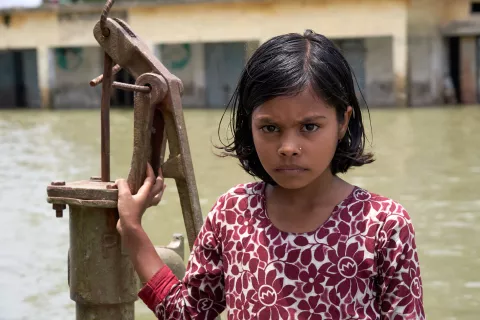Children are facing deadly drought in the Horn of Africa
Water crisis is devastating lives in Djibouti, Ethiopia, Kenya and Somalia.

- Available in:
- English
- Français
Consecutive years of below-average rainfall in the Horn of Africa have created one of the worst climate-related emergencies of the past 40 years.
The protracted drought is forcing families to leave their homes in search of food and water, putting their health, safety and education at risk.
Over 20 million people, including 10 million children, in Djibouti, Ethiopia, Kenya and Somalia will need water and food assistance through 2022.
As severe malnutrition and the risk of water-borne disease collide, children could die in devastating numbers unless urgent support is provided.
Above: A young boy collects the water he can find in a dried riverbed in Dolow, Somalia.
The impacts of climate change-induced drought in the Horn of Africa.
UNICEF and partners are on the ground to support children with life-saving services and to help build families’ longer term resilience in an effort to stop drought from devastating lives for years to come.
Forced to abandon home

10-year-old Hibo carries water in a jerrycan to her temporary home in a camp for internally displaced people in Somalia. “We left our home in Guriel and walked for 10 days to reach Kaharey camp," she says.
The scale of the displacement is immense – Somalia has 3.7 million internally displaced persons and Ethiopia has 4.2 million internally displaced persons and 800,000 refugees.


Families with children and adolescents on the move or in emergency camps are at risk of violence or abuse. It also forces women and children to spend increased time collecting water, exposing them to unsafe movement far from home.

Ayesha Abdi, 18, holds her child, in Waffi camp, Mogadishu, Somalia.
“We arrived at this camp seven days ago, hoping things will be better. My family has lost all our cattle and camels. They all died because we had no water to give them. We have nothing. We need things for our basic needs, like meals and water.”
Daily life rationed

Hafsa Bedel, a mother of six, is struggling to save the lives of her young camels in Ethiopia. Having already lost 25 livestock, she keeps them close to home for fear of them not finding food and water. “I can’t afford to feed them corn. We don’t even have enough for us,” she says.


People in Garissa County, Kenya, collecting water. Entire pastoral communities have been forced to leave their homes in search of water for their families and livestock.
A question of survival

Baby Sukra at a UNICEF-supported centre where children are treated for malnutrition in Somalia.
Poor access to safe water jeopardizes a child’s chance of survival. Water scarcity increases the risk of diarrhoea, a major killer of children under the age of 5, as well as diseases like cholera, hepatitis A, typhoid and polio.


Without water, crops cannot grow and animals and livestock die. The resulting loss of nutritious food, coupled with poor access to safe water and sanitation, exposes children to a high risk of malnutrition.

Obsinale, one year old, is recovering from malnutrition at a UNICEF-supported centre in Hargeisa Hospital, Somalia. She came here with her twin sister Mersinale who just got discharged after fully recovering. The beds here are full and there is only floor space for newly admitted children.
At least 330,000 children in Somalia need life-saving treatment for severe wasting, the deadliest form of malnutrition – much more than the 190,000 who required treatment during the country’s 2011 famine.
Education on hold
Drought is affecting school attendance in the affected areas. Overall, 15 million children in the Horn of Africa are now out of school and an additional estimated 3.3 million children are at risk of dropping out due to drought.

Abdurazak Mohammed, a sixth grader, takes his donkeys back home at dusk, in the Somali region of Ethiopia. “Many families sent their children with their cattle. The teachers also left. Then the school is closed. I feel sad to see my school closed. I want to be a teacher when I grow up.”


10-year-old Bukhari Aden accompanies his mother Dama Mohammed who collects water from a pond in Ethiopia. After giving water to the camels and donkey, they take two jerrycans back for the cows at home. He has never been to school. “In our village the children are responsible to look after the animals. There is no water near the village. If water is available nearby, it would be easy for me to go to school.”
Responding to the crisis
UNICEF and partners are providing life-saving services to children and their families in dire need across the Horn of Africa. We are on the ground providing essential health, nutrition, education and child protection services.
To provide longer term solutions, we’re working to improve access to climate-resilient water, sanitation and hygiene services, drilling for reliable sources of groundwater and developing the use of solar systems.

Fatuma pours water obtained from a solar-powered borehole installed by UNICEF with support from the UK Government in Puntland, Somalia. Her family owns 230 goats, sheep and camels that her father Abdirizak Yusuf watches over.
“This borehole is like an oasis in the huge desert with no water,” says Abdirizak.
The 400m deep climate resilient borehole provides around 18,000 people and their livestock with sustainable water.
What needs to happen
UNICEF has launched a regional call to action to address the drought crisis. If immediate funding needs are met, life-saving support may avert catastrophic consequences.
But recurrent droughts and increasing water insecurity need long-term investments in water, sanitation and hygiene services, water management, and climate-proof infrastructure. Climate change is leading to unpredictable variations in temperature and rainfall patterns, which is expected to increase, both in frequency and intensity.
Durable solutions are required to ensure water security for all, at all times.




